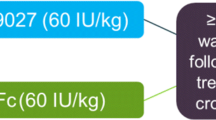Abstract
This paper presents a systemic investigation of ADA development and ADA impact of a human coagulation factor in nonclinical species during drug development and provides insights into potential implications in human if a similar ADA occurs. FXaI16L-induced ADA response was characterized in monkey, mouse, rat, and dog in different studies, and ADA effects on pharmacokinetic and/or pharmacodynamics of FXaI16L were further examined in ADA-negative and ADA-positive animals. After repeated administrations, FXaI16L elicited a dose and exposure day-dependent ADA response which ranged from no response to a transient or persistent response. Increase in exposure day and increase in dose generally enhanced ADA incidence except for a decrease in ADA incidence was observed in monkeys after repeated high-dose administrations. The observable ADA impact on pharmacokinetics was only found in some ADA+ animals and included decrease in clearance and increase in systemic exposure but no increase in half-life. In addition, no or limited effect on pharmacodynamics by ADA was observed. The earliest ADA response was observed after three exposure days, marked elevation of drug exposure was observed in some animals at log titer > 2.0, and the highest antibody titer excited was about 4 (Log10) in all species. A correlation between ADA induction and accumulative exposure after various repeat treatments in different species was found for FXaI16L. In addition, potential immunogenicity risk and mitigation of ADA in clinics are discussed.







Similar content being viewed by others
Abbreviations
- ADA:
-
Anti-drug antibody
- AUC:
-
Area under the curve
- Cmax:
-
Maximum observed concentration
- EGRCK:
-
Glu-Gly-Arg-chloromethyl ketone
- FEIBA:
-
Factor eight inhibitor bypassing agent (anti-inhibitor coagulant complex)
- FXa:
-
Active coagulation factor X
- nAb:
-
Neutralizing antibody
- PK:
-
Pharmacokinetics
- PD:
-
Pharmacodynamics
References
De Groot AS, Scott DW. Immunogenicity of protein therapeutics. Trends Immunol. 2007;28:482–90.
Koren E, Smith HW, Shores E, Shankar G, Finco-Kent D, Rup B, et al. Recommendations on risk-based strategies for detection and characterization of antibodies against biotechnology products. J Immunol Methods. 2008;333:1–9.
Tovey MG. Immunogenicity and other problems associated with the use of biopharmaceuticals. Ther Adv Drug Safety. 2011;3:133–28.
Sorensen PS, Ross C, Clemmesen KM, Bendtaen K, Frederiksen JL, Jensen K, et al. Clinical importance of neutralizing antibodies against interferon beta in patients with relapsing-remitting multiple sclerosis. Lancet. 2003;362:1184–91.
Scgnolari C, Bellomi F, Turriziani O, Bagnato F, Tomassini V, Lavolpe V, et al. Neutralizing and binding antibodies to IFN-beta: relative frequency in relapsing-remitting multiple sclerosis patients treated with different IFN-beta preparations. J Interf Cytokine Res. 2002;22:207–13.
Meeks SL, Batsuli G. Hemophilia and inhibitors: current treatment options and potential new therapeutic approaches. Hematol Educ Program. 2016;2016(1):657–62.
Gouw SC, van der Bom JG, Van den Berg HM. Treatment-related risk factors of inhibitor development in previously untreated patients with hemophilia a: the CANAL cohort study. Blood. 2007;109:4648–54.
Hermans C, Astermark J, De Moerloose P. Exposure to factor VIII and prediction of inhibitor development exposure days vs danger days or both? J Thromb Haemost. 2012;10:2194–6.
Hedner U. First 20 years with recombinant FVIIa (NovoSeven). Haemophilia. 2010;17:172–82.
Lamberth K, Weldingh KN, Ehrenforth S, Chéhadé MR, Østergarrd H. Immunogenicity lessons learned from the clinical development of Vatreptacog alpha, a recombinant activated factor VII analog, in hemophilia with inhibitor. Top Med Chem. 2017;20:123–60.
Mahlangu JN, Koh PL, Ng HJ, Lissitchkov T, Hardtke M, Schroeder J. The TRUST trial: anti-drug antibody formation in a patient with hemophilia with inhibitors after receiving the activated factor VII product bay 86–6150. In: Presented at 55th annual meeting of the American Society of Hematology 2013; Abstrat 573.
Parsons-Rich D, Hua F, Li G, Kantaridis C, Pittman DD, Arkin S. Phase 1 dose-escalating study to evaluate the safety, pharmacokinetics and pharmacodynamics of a recombinant factor Xa variant (FXaI16L). J Thromb Haemost. 2017;15(5):931–7.
Bunce MW, Toso R, Camire RM. Zymogen-like factor Xa variants restore thrombin generation and effectively bypass the intrinsic pathway in vitro. Blood. 2011;117(1):290–8.
Parng C, Markiewicz V, Chen J, Leary B, Duriga N, Dyleski L, et al. Preclinical pharmacokinetics, pharmacodynamics, tissue distribution and interspecies scaling of recombinant human coagulation factor FXaI16L. J Pharm Sci. 2017;106:2136–43.
Toso R, Zhu RH, Camire R. The conformational switch from the factor X zymogen to protease state mediates exosite expression and prothrombinase assembly. JBC. 2008;283(27):18627–35.
Bolt M, Hua F, Brenneman K, Graves J, Arkin S, Criswell K. Evaluation of potential safety biomarkers for monitoring thrombogenic potential of FXaI16L. Blood. 2014;124:4237.
Crotty S. A brief history of T cell help to B cells. Nat Rev Immunol. 2015;15(3):185–9.
Reinisch W. Eser A, Schreiber S, Kim H, Mould D. Clinical: therapy and observation. Reduction of dosing intervals is the preferable dose optimisation strategy for infliximab to suppress formation of anti-drug antibodies. 2018;401.
Kurnik K, Bidlingmaier C, Engl W, Chehadeh H, Reipert B, Auerswald G. New early prophylaxis regimen that avoids immunological danger signals can reduce FVIII inhibitor development. Haemophilia. 2010;16:256–62.
Acknowledgements
All of the authors are Pfizer employees and FXaI16 is a Pfizer clinical candidate. We thank all the support and guidance from the Pfizer FXaI16L development team. We also thank all the colleagues involved in development of FXaI16L in Pfizer whose dedication made all the studies possible.
Author information
Authors and Affiliations
Corresponding author
Additional information
Publisher’s Note
Springer Nature remains neutral with regard to jurisdictional claims in published maps and institutional affiliations.
Rights and permissions
About this article
Cite this article
Parng, C., Bolt, M., Pittman, D.D. et al. Induction and Impact of Anti-Drug Responses Elicited by a Human Recombinant Coagulation Factor FXaI16L in Preclinical Species. AAPS J 21, 52 (2019). https://doi.org/10.1208/s12248-019-0324-z
Received:
Accepted:
Published:
DOI: https://doi.org/10.1208/s12248-019-0324-z




